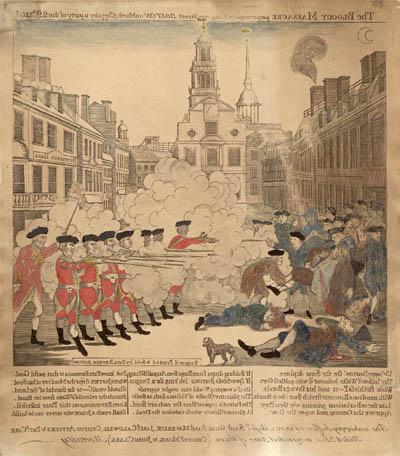The Bloody Massacre perpetrated in King Street, Boston on March 5th 1770 by a party of the 29th Regiment
To order an image, navigate to the full
display and click "request this image"
on the blue toolbar.
On the evening of 5 March, 1770, an unruly crowd gathered in Boston outside the Custom House on King Street to taunt with jeers and snowballs the British soldiers standing guard. Reinforcements were called, unordered shots rang out, and when the smoke cleared three locals lay dead and another eight were wounded, two mortally. The Boston Massacre quickly became a rallying point for anti-British sentiment in the province, and the real indignation of the people was further inflamed by colonial propaganda, one example of which is exhibited here.
Before the end of March, Paul Revere issued his engraving of the Bloody Massacre perpetrated in King Street. Working from an original drawing by Henry Pelham, Revere speedily produced his own engraving, which beat Pelham's to the street by a few days. A letter from Pelham to Revere, written on March 6, 1770, angrily begins: "When I heard that you were cutting a plate of the late Murder, I thought it impossible as I knew you was not capable of doing it unless you copied it from mine." Though at a quick glance the Revere and Pelham renderings of the massacre may appear identical, there are small but discernible variations in the figures, buildings and sky.
Although colorful and dramatic, the scene portrayed is historically inaccurate and inflammatory. The picture shows a line of Redcoats with Capt. Preston urging a point-blank volley into a defenseless crowd, when in fact there was no such organized military action and the civilians comprised an unruly mob of 60. Nonetheless, such a vivid representation of the viciousness of the British made for powerful propaganda. Revere, an ardent patriot, exploited the opportunity, adding his own touches, such as the sign that reads "Butcher's Hall" over the British-guarded Custom House. Appearing so soon after the event, the engraving was enthusiastically admired and widely circulated, and it continues even today to serve as the popular conception of an historical moment.
Text adapted from entry by Barbara M. Pugliese and Virginia H. Smith, Witness to America's Past: Two Centuries of Collecting by the Massachusetts Historical Society (Boston: Massachusetts Historical Society and Museum of Fine Arts, Boston, 1991).

